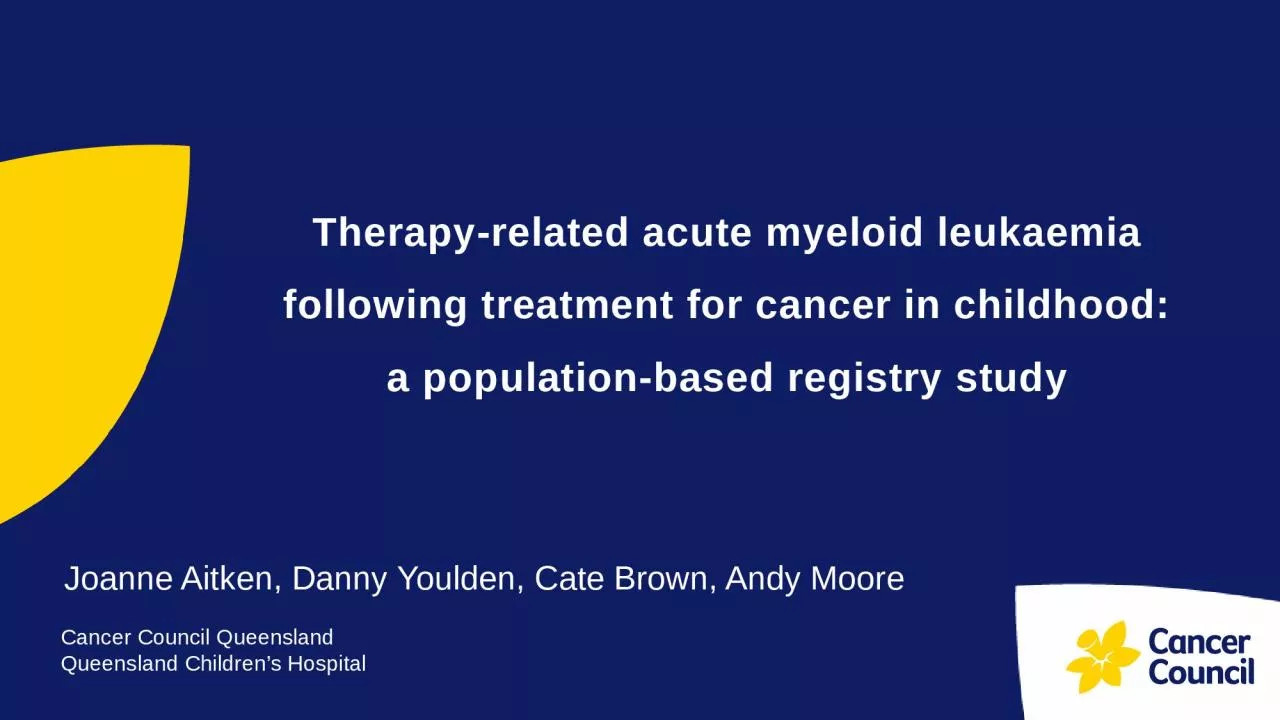

Joanne Aitken Danny Youlden Cate Brown Andy Moore Cancer Council Queensland Queensland Childrens Hospital Background tAML occurs in patients exposed to cytotoxic chemotherapy andor radiotherapy ID: 1033000
Download Presentation The PPT/PDF document "Therapy-related acute myeloid leukaemia ..." is the property of its rightful owner. Permission is granted to download and print the materials on this web site for personal, non-commercial use only, and to display it on your personal computer provided you do not modify the materials and that you retain all copyright notices contained in the materials. By downloading content from our website, you accept the terms of this agreement.
1. Therapy-related acute myeloid leukaemia following treatment for cancer in childhood: a population-based registry studyJoanne Aitken, Danny Youlden, Cate Brown, Andy MooreCancer Council QueenslandQueensland Children’s Hospital
2. Backgroundt-AML occurs in patients exposed to cytotoxic chemotherapy and/or radiotherapy Rare disease with a poor prognosisMost of what is known about t-AML comes from studies of adult cancer
3. DataAustralian Childhood Cancer Registry Includes all children (<15 yrs) diagnosed with cancer in AustraliaAnnual matching against the Australian Cancer Database (for later cancers) and the National Death IndexTreatment details are collected for first and subsequent cancers diagnosed <15 years of age
4. Eligibility criteriaFirst primary cancer other than AMLFirst diagnosis between 1983 and 2012Treated with chemotherapy and/or radiotherapy (with start date of treatment recorded)
5. Determination of t-AMLFirst and second cancers for the same patient were matched using a unique registry numberAny subsequent AML was assumed to be t-AML (after initiation of treatment for the first cancer)
6. Time at riskFollow-up for second diagnosis available to Dec 31, 2014.Time at risk was calculated from date of first treatment until either: - end of the study period - date of death - date of diagnosis of t-AMLMaximum age at end of follow-up = 46 years
7. AnalysisStandardised incidence ratios (SIRs) calculated to measure relative risk of t-AMLObserved survival from date of diagnosis of t-AML estimated using Kaplan-Meier methodKey variables of interest: - sex - age group - period of diagnosis - type of first cancer - treatment received (<15 years old)
8. Study cohort58 (0.5%) of 11,753 eligible patients were diagnosed with t-AMLTwo-thirds were males; almost half aged 0-4 yrs at first diagnosis78% t-AML cases diagnosed within 5 years of first cancer 76% t-AML cases aged <15 yrs at diagnosis of t-AML, none diagnosed after age 24 yrsOnly 8 cases of t-AML had correct morphology code (M99203)98% of t-AML patients had had chemotherapy, 34% had also had radiotherapy
9. Relative risk of t-AMLCharacteristicnSIR (95% CI)TOTAL5845.6 (35.3-59.0) Male3952.7 (38.5-72.1) Female1935.7 (22.8-56.0) First cancer Blood cancer2940.8 (28.3-58.7) Solid tumours2951.7 (36.0-74.5)Treatment for first cancer Chemotherapy5749.0 (37.8-63.6) Radiotherapy2041.2 (26.6-63.9) HSCT 7120.7 (57.5-253.2)
10. Treatment for t-AMLt-AML treatment details were available for 44 children diagnosed <15 years75% received chemotherapy plus either HSCT (48%) or radiotherapy (11%)Of the 40 patients where remission status was recorded, complete remission was achieved for: - 95% of 21 with HSCT - 21% of 19 without HSCT
11. Survival following t-AML71% of the 58 t-AML patients had died by 31 Dec 2104Five-year observed survival was 31.2% (95% CI = 19.6%-43.5%)No significant differences in survival by: - sex (although maybe males worse) - age at t-AML diagnosis - year of t-AML diagnosis - time from first to second diagnosis - type of first cancer
12. Survival following t-AML by HSCTFive-year observed survival:HSCT = 52.4% (29.7%-70.9%)No HSCT = 5.7% (0.4%-22.6%)p < 0.001
13. Conclusions t-AML is an important late effect of childhood cancer treatment (accounts for 17% of second primary cancers following childhood cancer in Australia)Imprecision in coding may hinder research into t-AMLMale predominance combined with possible survival disadvantage – further investigation warrantedPatients should be prepared for HSCT as soon as possible after diagnosis with t-AML
14. Want to know more?Brown CA, Youlden DR, Aitken JF, Moore AS. Pediatr Blood Cancer. 2018;65:e27410
15. Thank you and questions?